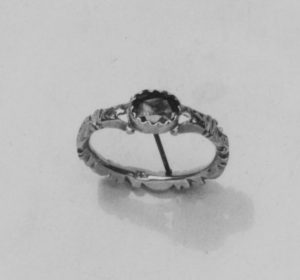A mourning rings are a piece of jewelry worn by a man or a woman to remind himself of a dead loved one. It could contain the name or date of death of the dead person. Sometimes, it would have the image of the person or a written motto.

It contained a lot of sentimental values. They were designed and paid for by the person who has passed away at the time when he or she was alive.
It was also decided and told by them as to who gets to possess the ring. As the name suggests, they symbolized mourning of a person for another person who was a loved one.
History of the Mourning Rings
The origin of the mourning ring dates back to the 14th century. However, they are recognized significantly after the death of King Albert when Queen Victoria popularised a mourning ring she wore in remembrance of her husband.

In the 17th century came the Momento Mori rings, which came out of the Latin Christian Theory of Momento Mori.
Modern Mourning Jewelry
The mourning rings would signify the deads non-existence. One wearing a mourning ring would be shown sympathy as they displayed the loss of a loved one through the ring.

There was no discrimination as to who would wear the rings. The rich class and the poor class both used mourning jewelry among which the ring was most popular.
How were the Mourning Rings Made?
The Mourning rings were a symbol of sadness. It represented “loss”. Hence, they weren’t supposed to be fancy at all. They were decorated with symbols such as the weeping willow, broken columns and other classical figures.
There would be minor personalizations made such as the name and day of death of the loved one either inscribed or painted or an image of the dead loved the one on the ring.

In the later 1700s, the rings became more popularised and gained too much fascination and creativity. There were images of figures stretched out over the tomb and people walking with their head in their hands.
With fascination, a classic style was also maintained in the 17th century. Black colored stones were mounted on the rings as a symbol of grief and pain. Black enamel or vulcanite would be used where required.
Black Rings
In the 16th century, the black rings would represent that the dead person was unmarried or juvenile. In some cases, a lock of hair of the dead person would be put inside the ring.

This ring would then consist of a part of the person and was highly cherished. However, this practice didn’t last too long since the people couldn’t be so sure of whose hair was being incorporated.
Mourning Rings Belonging to Well-Known Persons
Cesar Picton
Cesar Picton A young boy enslaved in Africa and brought to England by an English Army Officer later became a wealthy coal merchant in Kingston.

He bequeathed sixteen rings for his mourning amongst his family and friends.
William Shakespeare
William Shakespeare A famous English poet, playwright, and actor bequeathed a mourning ring to his daughter Susanna Hall.

He was and still is regarded as the best writer in English literature.
William Skirving
William Skirving One of the five Scottish martyrs for liberty. He died in 1796.

More Info On- Victorian Betrothal Rings, Victorian Era Jewellery, Victorian Era Mourning Period Rituals